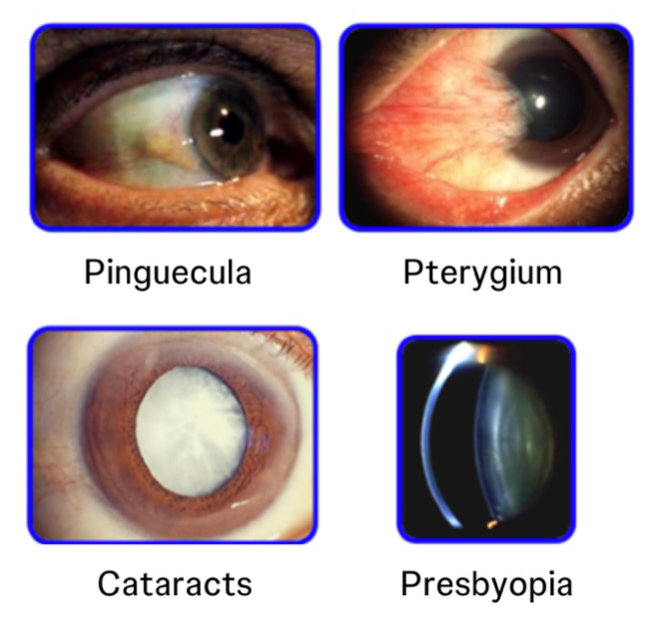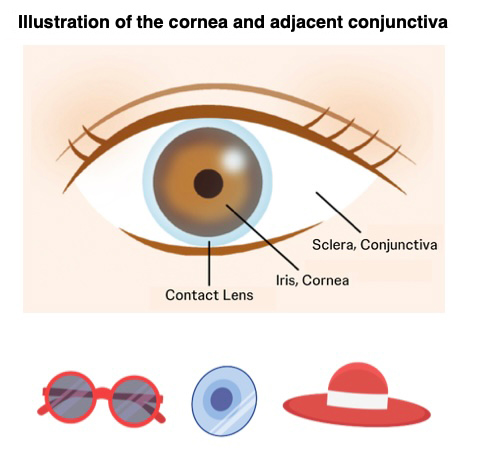Learn about eye diseases caused by ultraviolet rays
Have you ever heard of the term "sunburn of the eyes"? Regardless of the season, exposure to ultraviolet (UV) rays can cause inflammation within the eye, specifically to the corneas1. Compared to the effects of ultraviolet rays on the skin, awareness of the effects of ultraviolet rays on the eyes is still not widespread. There are several diseases caused by the effects of ultraviolet rays1. We spoke to Dr. Hiroshi Sasaki, Professor and Chairman of Department of Ophthalmology at Kanazawa Medical University, a leading researcher in the field of eyes and ultraviolet rays, about diseases and preventive measures.
Key facts:
- Even on cloudy days or during winter activities, UV rays can penetrate clouds. Making UV protection a necessity all year long1.
- Protecting your eyes from the sun can reduce risk of developing certain eye conditions, like cataracts, eyelid cancers, or macular degeneration – a disease that can lead to vision loss1.
- Using multiple items to protect against UV rays is effective. The best way to protect your eyes is to wear proper eye protection, such as sunglasses that block 99% to 100% UVA/UVB rays. For additional protection, you can also wear a large, wide-brimmed hat1.
Your eyes are exposed to UV rays from morning until evening.
"Compared to the skin, the eyes are exposed to UV rays from morning to evening all year round," Dr. Sasaki explains.
Eye diseases caused by UV rays can be divided into acute and chronic disorders. Although it varies depending on the season and region, short periods of exposure to strong UV rays, such as skiing on a snowy mountain in spring or being outdoors all day for school club activities, can cause the eyes to become bloodshot2. This is an acute disorder2. Acute cases will heal over time with the proper treatment2. On the other hand, repeated exposure to strong UV rays can cause chronic disorders1.
Cataracts, the #1 cause of preventable blindness worldwide3, are also affected by UV rays4
What kind of eye diseases and effects are caused by UV rays? According to Dr. Sasaki, there are four main chronic disorders: pinguecula, pterygium, cataracts, and presbyopia1.
"Pingueculitis is a condition in which yellow spots or bumps appear on the white of the eye. Acute inflammation in this region may occur, causing redness and irritation. UV rays increase the risk of developing this condition," said Dr. Sasaki.
The closer you get to the equator, the stronger the UV rays are5. In a survey conducted by Dr. Sasaki on Japanese people living in Ishikawa Prefecture and primary, junior high, and high school students in Tanzania, located in the equatorial part of Africa, he found that the prevalence of early-stage pinguecula was significantly higher in Tanzanians.
Pterygium develops when exposed to stronger UV rays6. Raised, fleshy tissue stretches to cover the iris. In some cases, the patient may feel a foreign body in the eye, or the surface of the cornea may become uneven, causing irregular astigmatism, which means that images cannot be focused properly, and surgery may be required6.
Cataracts, the world's #1 cause of preventable blindness3 are also affected by UV rays. Cataracts are a disease in which the eye's lens becomes cloudy, making it difficult for light to pass through and making it difficult to see3. UV rays cause damage to the lens, which acts as a lens for the eye, and cause the proteins that make up the lens to become cloudy4.

Dr. Sasaki is also researching the relationship between heatstroke and cataracts. He said, during his research, he found that people who have experienced heatstroke are four times more likely to develop cataracts five years later than those who have not experienced heatstroke.
In a survey conducted in Japan by Johnson & Johnson in 2016 on 832 men and women in their 30s to 60s, people who were aware of their high exposure to UV rays were more likely to answer that they became aware of their presbyopia "earlier" or "slightly earlier" than those around them than those who were exposed to less UV rays.
Using multiple items to protect against UV rays is effective
What kind of UV protection is available for the eyes?
Dr. Sasaki lists the following points as daily measures to protect against UV rays:
- Use a wide-brimmed hat and UV-blocking sunglasses, contact lenses, or glasses1.
- UV-blocking contact lenses contain UV-absorbing agents in the material, which allows them to block UV rays. Contact lenses that cover the entire iris and part of the white of the eye reduce the penetration of UV rays to the cornea and the conjunctiva adjacent to the cornea.

Sunglasses: If you want to protect your eyes, the first thing to do is to wear sunglasses. However, there is a blind spot to this: UV rays can get in through the side of the lens, causing the "coroneo effect" that can damage your eyes7.
UV-blocking contact lenses: Blocks UV rays that enter through the gaps in sunglasses (spectacles) from being absorbed by the eyes. In order to prevent the "coroneo effect", it is effective to use UV-blocking contact lenses in addition to sunglasses (spectacles) 7.
Hats: Hats are also an important item. Considering your eyes, we recommend straw hats or tulip hats that can cast a shadow in front of your eyes.
The risk can be reduced by correctly understanding the effects of UV rays on the eyes and taking preventive measures1.
It is said that people take in 80% of information through their eyes8. As the season approaches when UV rays become stronger, it is important to take measures.

Who we interviewed
Dr. Hiroshi Sasaki, Professor and Chairman of the Department of Ophthalmology, Kanazawa Medical University
After graduating from Kanazawa University, he obtained his medical license in 1987. After working at Jichi Medical University and Oakland University Eye Research Institute in the US, he transferred to the Department of Ophthalmology at Kanazawa Medical University in 1996, where he became a professor in 2005. He has conducted epidemiological surveys of UV-related eye diseases both in Japan and overseas, and is a leading doctor in Japan in the areas of clinical, epidemiological and basic research into cataracts. He has performed over 40,000 cataract surgeries to date.
References:
- Health News Team. (2023, July 7). Can you sunburn your eyes? www.sharp.com/health-news/can-you-sunburn-your-eyes
- Cleveland Clinic. (n.d.). What is photokeratitis?. Cleveland Clinic. https://my.clevelandclinic.org/health/diseases/15763-photokeratitis
- American Academy of Ophthalmology. (2024, May 23). Cataract. AAO.org. https://eyewiki.aao.org/Cataract#:~:text=This%20cloudiness%20can%20cause%20a,one%20cause%20of%20preventable%20blindness.
- U.S. Department of Health and Human Services. (n.d.-b). New research sheds light on how UV rays may contribute to Cataract. National Eye Institute. https://www.nei.nih.gov/about/news-and-events/news/new-research-sheds-light-how-uv-rays-may-contribute-cataract
- World Health Organization. (n.d.). Radiation: Ultraviolet (UV) radiation. World Health Organization. https://www.who.int/news-room/questions-and-answers/item/radiation-ultraviolet-(uv)#:~:text=UV%20levels%20are%20higher%20closer,UV%20radiation%20can%20be%20absorbed.&text=With%20increasing%20altitude%20less%20atmosphere%20is%20available%20to%20absorb%20U.
- Boyd, K. (2024, May 10). What is a Pinguecula and a pterygium (Surfer’s eye)? American Academy of Ophthalmology. https://www.aao.org/eye-health/diseases/pinguecula-pterygium
- Chawda, D., & Shinde, P. (2022, October 29). Effects of solar radiation on the eyes. Cureus. https://www.ncbi.nlm.nih.gov/pmc/articles/PMC9709587/#:~:text=A%20unique%20aspect%20of%20albedo,of%20the%20lens%20%5B6%5D.
- Lazarus, R. (2020, April 6). Vision and learning difficulties. Optometrists Network. www.optometrists.org/vision-therapy/guide-vision-and-learning-difficulties/vision-and-learning-difficulties
2024PP11839

